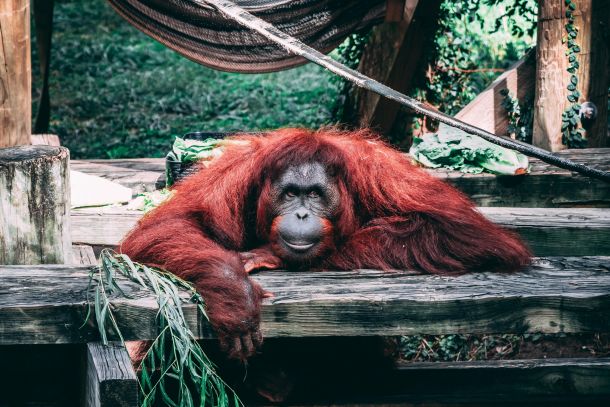
Photo by David Gonzales from Pexels
Orangutan: The name orangutan means “man of the forest” in the Malay language.
Kingdom: | Animalia
Phylum: | Chordata
Class: | Mammalia
Order: | Primates
Family: | Pongidae
Genus: | Pongo
There are two species of orangutan: Bornean (Pongo pygmaeus) and Sumatran (Pongo Abelli). Bornean and Sumatran orangutans differ slightly in appearance and behavior. Both species have drastically declined in population in recent years.
In November 2017, a third species of orangutan was announced. With no more than 800 individuals in existence, the Tapanuli orangutan (Pongo tapanuliensis) is the most endangered of all great apes, according to the World Wildlife Foundation (WWF).
These shaggy red apes are the largest arboreal mammal and are only great ape found in Asia. The other great apes are all native to Africa, including gorillas, chimpanzees and bonobos.
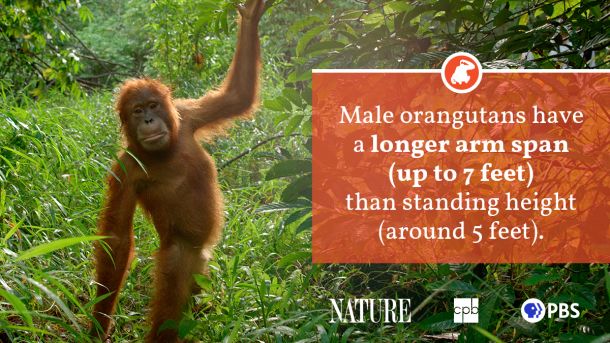
Size and Weight:
On average, females are 45 inches in height and weigh about 81.5 pounds. Males average 54 inches in height and 191 pounds.
Appearance:
Orangutans are known for their long, flowing, reddish hair, which covers most of their gray skin. They have a stocky body with a flexible pelvis, a thick neck, and bowed legs. They have long arms that help them swing from branch to branch. Their arms are much longer than their legs, reaching nearly to its ankles when the ape stands up. Like other apes, orangutans don’t have a tail.
The Sumatran and Bornean orangutans differ slightly in appearance. The Bornean orangutans are slightly darker in color and more heavy-set. They have a broader face and shorter beards. The males have larger cheek pads, known as flanges.
There are two morphs of mature males within both species. There are cheek-padded males or flanged males, with big cheek pads on the side of his face and a large throat sac under his chin. Flanged males are more likely to have facial hair and longer hair on their backs.
Meanwhile, unflanged males do not have these traits. They are typically smaller in size. While both flanged and unflanged males can father offspring, flanged males tend to attract more females as they are better fathers.
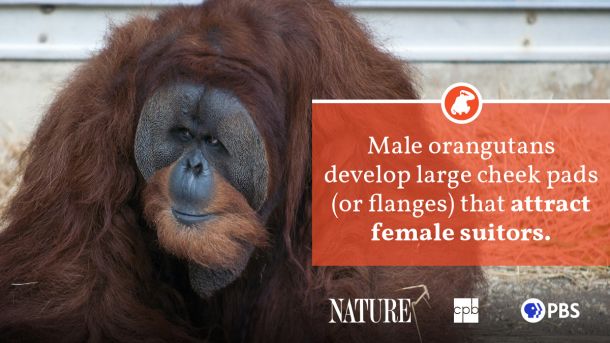
Diet:
Orangutans feast on wild fruits, up to 100 different types of fruit, such as lychees, mangosteens, and figs. When fruits are scarce, they may eat leaves, flowers, bark, honey, termites, ants and other insects, and even bird eggs.
While they consume lots of water from the fruits and vegetation that they eat, they also slurp water from holes in trees.
Habitat:
Orangutans spend most of their time in trees and live in forest habitats. They travel from tree-to-tree by using their long arms. They typically build a new nest every night out of twigs and branches.
Orangutans have large home ranges. Each adult female usually lives in a stable home range of about 3.5 square miles, whereas an adult male’s territory may be up to 15 square miles. A male’s range may overlap with the territory of several females. Males tend to be more nomadic, visiting female ranges as needed. Males typically do not overlap with other males. If a male enters a territory occupied by a more dominant male, the dominant male gives a booming roar called a “long call” to scare off the intruder.
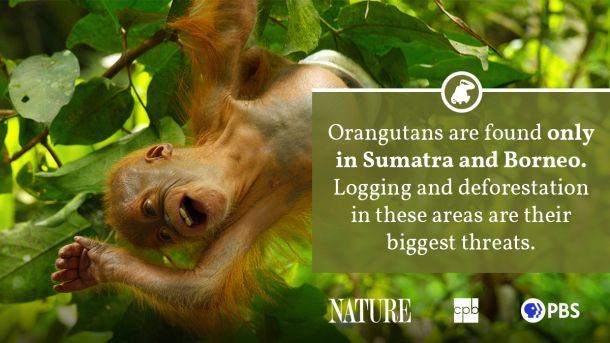
Geography:
Orangutans live in tropical and swamp forests on the Southeast Asian islands of Borneo and Sumatra.
Historically, the Sumatran orangutan was distributed over the entire island of Sumatra and further south into Java. The species’ range is now restricted to the north of the island with a majority in the provinces of North Sumatra and Aceh.

Breeding:
Male orangutans’ calls can serve as an invitation to any available females within hearing distance. The females seem to be impressed by a male orangutan’s flanges.
Orangutans have the slowest breeding rate of all mammals. They reproduce only every seven or eight years, which is the longest interval of all land mammals. The females usually have their first baby between age 12 to 15, which is late compared to other mammals.
Newborns have pink faces that change to dark brown or black as they age. For its first few weeks of life, the baby holds tight to its mother’s belly as she swings through the forest in search of fruit. When it is older and better at balancing, the young rides atop the mother’s back.
Young orangutans may nurse up to seven years. While they grow more independent as they age, they’ll stay close to their mother during this time. This is the longest childhood period of the great apes.
Experts used to think orangutans were solitary, but recent studies show that they may travel in small groups. On Sumatra, small groups or pairs of adolescents, a few adult females, or even a small group of non-cheek-padded males may travel together for a few days at a time. Meanwhile, flanged males are solitary except when breeding or fighting another male. They compete for mates and territory, and they don’t tolerate each oth
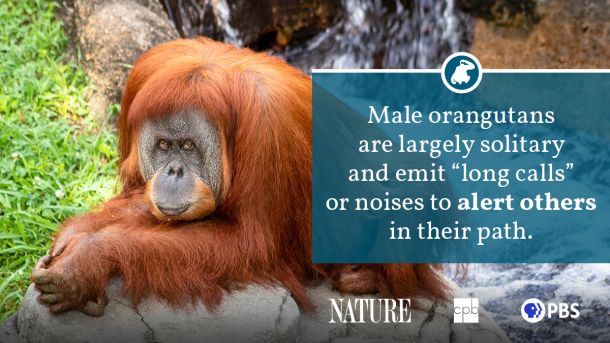
Lifespan:
Orangutans live up to 59 years in zoos.
Threats:
Deforestation and habitat loss is a major threat to orangutans. Their habitats are quickly disappearing, as they make way for oil palm plantations and other agricultural plantations. More than 50% of orangutans are found outside protected areas in forests under management by timber, palm oil and mining companies.
Hunting and the illegal wildlife trade is another major threat to these species. They are an easy target for hunters because they’re large and slow-moving. Orangutans are typically killed for food or in retaliation if they are to move into agricultural areas where they destroy crops. The females tend to be hunted more often, and when caught with their offspring, the young may be kept as a pet. The pet trade is another major threat to orangutans, where many orangutans die in the process of the trade.
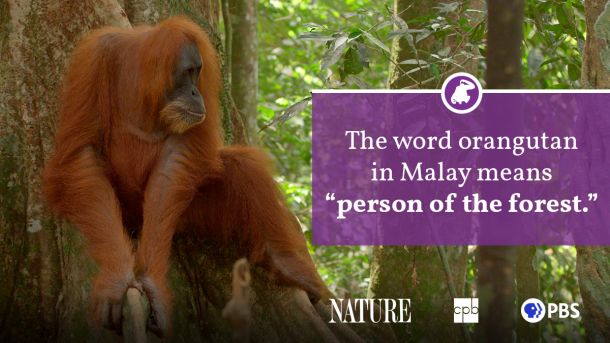
Conservation Status:
All three species of orangutan are critically endangered. There are about 104,700 Bornean, 13,846 Sumatran and only 800 Tapanuli.
Conservation Efforts:
Numerous conservation groups are working to protect these endangered species, including WWF and the San Diego Zoo. WWF has been working on orangutan conservation since the 1970s. They are working to conserve orangutan habitat and to promote sustainable forestry. They are also working to halt the illegal pet trade and poaching.
San Diego Zoo Global is also working to raise awareness of the threats to orangutans, and all great apes. They also provide financial funding to support various conservation projects.
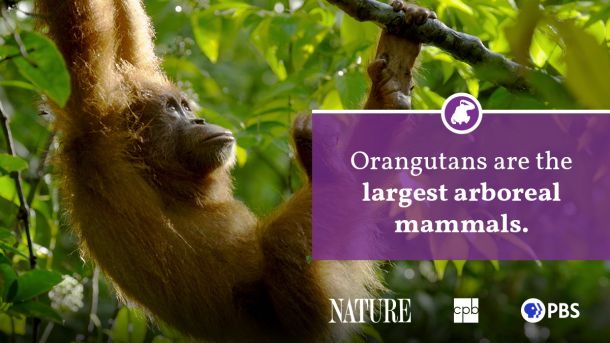
How You Can Help:
Support conservation groups, such as the San Diego Zoo and WWF, and their efforts to help these endangered species.
Adopt an Orangutan: make a symbolic adoption of an orangutan to help save the species.
Source: WWF and the San Diego Zoo
